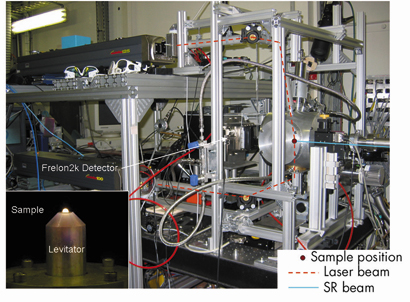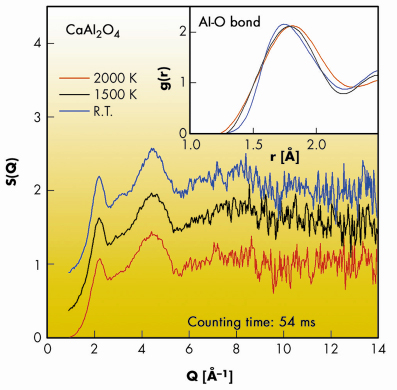- Home
- Users & Science
- Scientific Documentation
- ESRF Highlights
- ESRF Highlights 2007
- Materials Science
- Time-resolved structural study of the glass transition in glass forming liquids
Time-resolved structural study of the glass transition in glass forming liquids
Although the phenomena of supercooling and glass transition have been the subject of considerable study over the past ten years, understanding glass formation is still a challenge in condensed matter physics. It is therefore important to develop experimental techniques capable of probing the evolution of glass structure during the cooling from the liquid state to room temperature.
Aerodynamic levitation combined with laser heating has proved to be a powerful and versatile technique for studying the structure and dynamics of refractory oxide liquids [1,2]. In particular, this method eliminates the problems of sample-container interactions and contamination and it makes it possible to obtain the rapid quench necessary for glass formation.
Time-resolved structural studies during the glass transition require fast X-ray diffraction (XRD) measurements since the process occurs within a few seconds. Therefore, an aerodynamic levitation setup has been designed and installed at the ID11 beamline where time-resolved diffraction measurements were performed using the ESRF Frelon detector.
The experimental setup is shown in Figure 29. Spherical samples with diameters between 2.5 and 3 mm were aerodynamically levitated using an argon/oxygen gas jet and melted with two CO2 lasers heating the sample from the top and from the bottom in order to have a homogeneous temperature. The laser beams are focused onto the sample using several spherical copper mirrors. The temperature is measured using an optical pyrometer. A 10 x 10 cm2 high-resolution fast CCD detector was placed close to the levitation chamber. Time-resolved X-ray measurements require short counting times with good statistics over a wide range of scattering vector Q. For the experiment we used high energy monochromatic X-rays (80 keV), giving a maximal Q value of about 19 Å–1. The high-temperature setup is controlled remotely with a computer and synchronised with diffraction measurements.
 |
|
Fig. 29: Aerodynamic levitation experimental setup at ID11. |
We studied the structural evolution of the liquid glass former CaAl2O4 as it cooled from the stable liquid phase well above the melting point Tm (1878 K) to the cold glass below Tg (1173 K). Fast diffraction measurements were carried out with counting times of 54 ms. Figure 30 shows the structure factors measured at three temperatures: in the stable liquid, in the supercooled state, and in the glass at room temperature. The inset presents the corresponding pair distribution functions g(r) calculated using the Fourier transform of S(Q).
The evolution is characterised by a sharpening of the first sharp diffraction peak and a shortening of the average nearest-neighbour bond length at about 1467 K, indicating an increase in the degree of both intermediate-range and short-range order. This transformation occurs close to the crossover temperature (~1.2 Tg).
This work shows that the combination of aerodynamic levitation and laser heating with fast XRD is a powerful technique for obtaining reliable structural information during glass formation.
 |
|
Fig. 30: Time-resolved measurements at different temperatures for CaO-Al2O3 with their respective Fourier transforms in the insert. |
References
[1] L. Hennet, D. Thiaudière, M. Gailhanou, C. Landron, J.P. Coutures, D.L. Price, Rev. Sci. Instrum. 73, 124 (2002).
[2] I. Pozdnyakova, L. Hennet, J.-F. Brun, D. Zanghi, S. Brassamin, V. Cristiglio, D.L. Price, F. Albergamo, A. Bytchkov, S. Jahn, M.-L.Saboungi, J. Chem. Phys. 126, 114505 (2007).
Principal publication and authors
A. Bytchkov (a), L. Hennet (b), I. Pozdnyakova (b), D. Zanghi (b), D.L. Price (b), F. Kargl (c), N. Greaves (c), S. Jahn (d).
(a) ESRF
(b) CRMHT, Orléans (France)
(c) University of Wales, Aberystwyth (UK)
(d) GFZ, Telegrafenberg, Potsdam (Germany)



